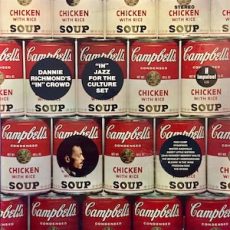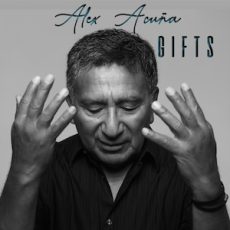
Daily Dose Of Jazz…
Dannie Richmond was born Charles Daniel Richmond on December 15, 1931 in New York City and grew up in Greensboro, North Carolina. He started playing tenor saxophone at the age of thirteen, and went on to play R&B with the Paul Williams band in 1955.
His career took off when he transferred his talents to the drums, which he had taught himself to play in his early twenties, through the formation of what was to be a 21-year friendship and an indispensable ingredient of the Mingus sound. Upon Mingus’ death Richmond became the first musical director of the group Mingus Dynasty in 1980.
Drummer Dannie Richmond, best known for his work with Charles Mingus, died of a heart attack in Harlem, New York on March 16, 1988, at the age of 56.
More Posts: drums,history,instrumental,jazz,music

Daily Dose Of Jazz…
Anna Maria Jopek was born on December 14, 1970 in Warsaw, Poland, the daughter of Mazowsze singer Stanisław Jopek, known as the First Coachman of Poland.
Representing her country in the 1997 Eurovision Song Contest with the song Ale jestem, she finished 11th out of 25 competitors. By 2002 she was collaborating on an album with jazz guitarist Pat Metheny. She has received numerous awards for her music, including Michel Legrand’s Personal Award in Vitebsk, Belarus in 1994.
Anna has sung with Polish musicians Marek Grechuta, Jeremi Przybora and Wojciech Młynarski as well as abroad with Youssu’n Dour, Bobby McFerrin, Ivan Linz, Branford Marsalis, Nigel Kennedy, Richard Bona, Oscar Castro-Neves, Makoto Ozone, Sting and Gonzalo Rubalcaba among others.
In 2015, Jopek received the Knight’s Cross Order of Polonia Restituta conferred by President Bronisław Komorowski for promoting Polish art worldwide.
Vocalist, songwriter and improviser Anna Maria Jopek, who has recorded twelve studio and two live albums as a leader, continues to pursue beyond the boundaries of her musical range.
More Posts: bandleader,history,improviser,instrumental,jazz,music,songwriter,vocal

Daily Dose Of Jazz…
Róbert Rátonyi was born December 13, 1953 in Budapest, Hungary. At the age of six he started to learn solfeggio before turning to the piano. He later became a student of Klára Géczy Fazekas, however, following his art studies and the grammar school graduation, he attended the Bartók Béla Music Conservatory, specializing in jazz.
His style of playing is influenced by Bill Evans, Ahmad Jamal, Bob James, Kenny Barron, Andy Laverne and Herbie Hancock. Beginning in 1975 he has played together with all leading Hungarian jazz musicians in concerts and festivals at home and abroad.
Besides jazz, he is one of the most frequently engaged studio musicians. He has written and composed music for numerous films, theatre, shows and advertisements. He is also a consummate accompanist for many vocalists.
Pianist, arranger, and composer Róbert Rátonyi, known for his work in jazz and studio music, while also teaching jazz piano and electronic instruments, has been awarded the Artisjus Award and continues to perform and record.
More Posts: arranger,bandleader,composer,history,instrumental,jazz,music,piano

Daily Dose Of Jazz…
Alex Acuña was born Alejandro Neciosup Acuña on December 12, 1944 in Pativilca, Peru. He played in local bands such as La Orquesta de los Hermanos Neciosup from the age of ten, then followed his brothers and moved to Lima, Peru as a teenager. At the age of eighteen he joined the band of Perez Prado, and in 1965 moved to San Juan, Puerto Rico.
In 1974 he moved to Las Vegas, Nevada and worked with Elvis Presley, The Temptations, and Diana Ross. The following year he joined the jazz-fusion group Weather Report, and while in New York City, Acuña recorded several songs for RCA records. Leaving Weather Report in 1978 he became a session musician in California, recording and playing live with r&b and jazz musicians Ella Fitzgerald, Michael Jackson, Chick Corea, Wayne Shorter, Joe Zawinul, Herbie Hancock, Carlos Santana, Antonio Carlos Jobim, Roberta Flack,Al Jarreau and the list goes on and on.
The Eighties saw Alex recording and touring with the Christian jazz band Koinonia. In 1987 he was summoned back to Perú by producer Ricardo Ghibellini to be the musical producer of Los Hijos del Sol, a group of Peruvians designed to promote Peruvian music worldwide.
Drummer and percussionist Alex Acuña, who has worked as an educator at University of California Los Angeles, and Berklee College of Music, LAMA, Musicians Institute, USC, and CSUN, continues his career of performing and educating.
More Posts: bandleader,drums,history,instrumental,jazz,music,percussion

Daily Dose Of Jazz…
Beegie Adair was born Bobbe Gorin Long on December 11, 1937 in Cave City, Kentucky. She began playing the piano at the age of five and graduated from Caverna High School in 1954. She went on to earn a Bachelor of Science degree in music education at Western Kentucky University in 1958.
Relocating to Nashville, Tennessee, in 1961 she worked as a children’s music teacher for three years. There she played in Printer’s Alley and became a member of a jazz band led by Hank Garland. Beegie would go on to accompany Dinah Shore, Peggy Lee, Ray Stevens, Steve Allen, Chet Atkins, Cass Elliot, Vince Gill and Dolly Parton. At various times she played for the Noon Show on WSM-TV, The Johnny Cash Show and other programs.
Partnering with Denis Solee in 1982 they established the Adair–Solee Quartet, which evolved into the sextet Be-Bop Co-Op. She released her debut solo album as a leader in 1988 with Escape to New York, then formed the Beegie Adair Trio, which sold more than 1.5 million albums.
Throughout her 60-year career Beegie appeared on more than 100 recordings. Of these, 35 were recorded by her trio which included bassist Roger Spencer and percussionist Chris Brown. She released a six-CD centennial collection, The Great American Songbook Collection.
Adair was an adjunct professor of jazz studies at Vanderbilt University’s Blair School of Music. She was a faculty and board member of the Nashville Jazz Workshop, where she often performed. She was named a Steinway Artist and was inducted into Western Kentucky University’s Hall of Fame, Cave City’s Hall of Fame and was the inaugural recipient of Nashville Jazz Workshop’s Heritage Award.
Pianist and bandleader Beegie Adair, whose career spanned more than 60 years, died at her home in Franklin, Tennessee on January 23, 2022, at the age of 84.
More Posts: bandleader,history,instrumental,jazz,music,piano


